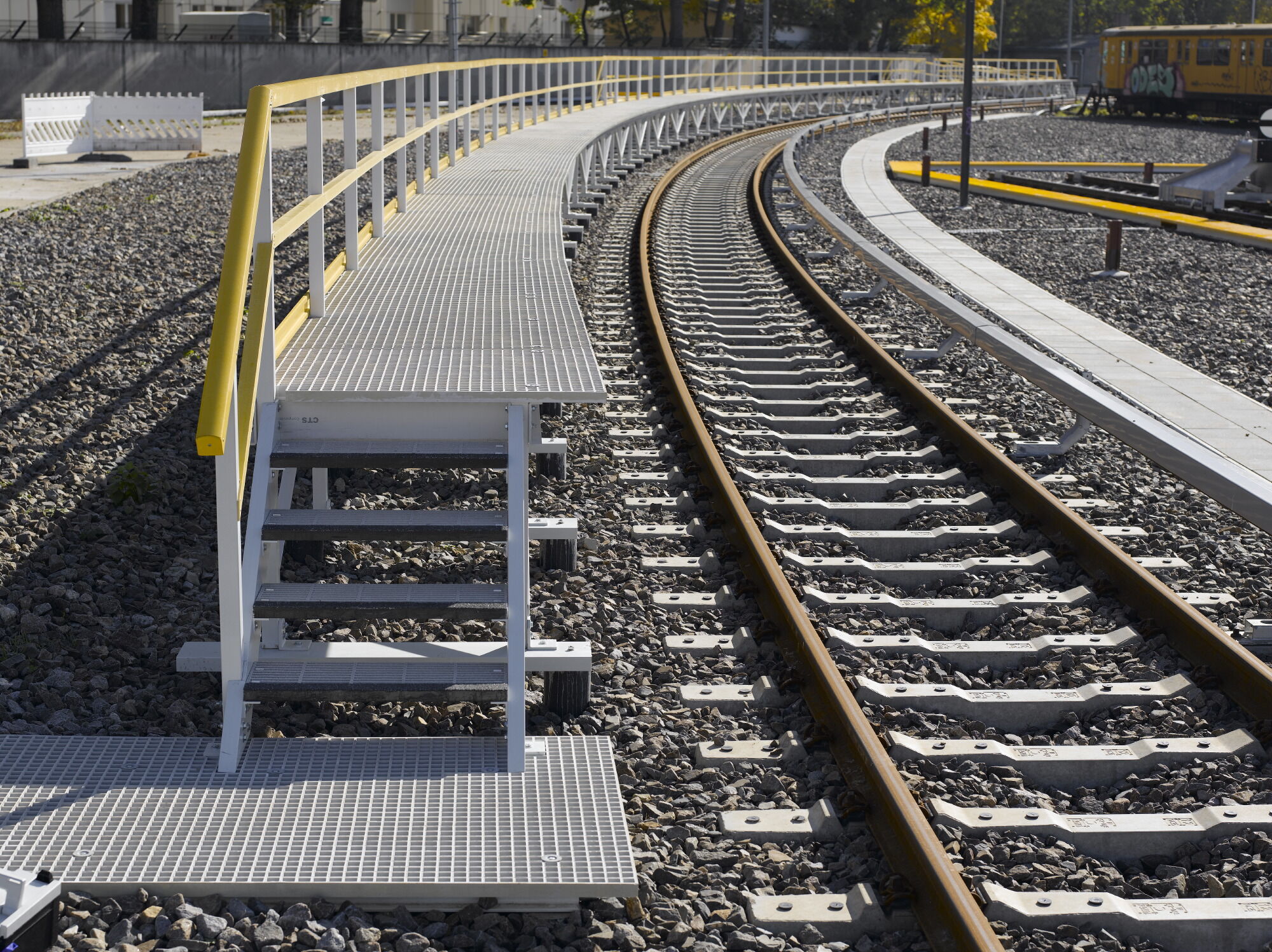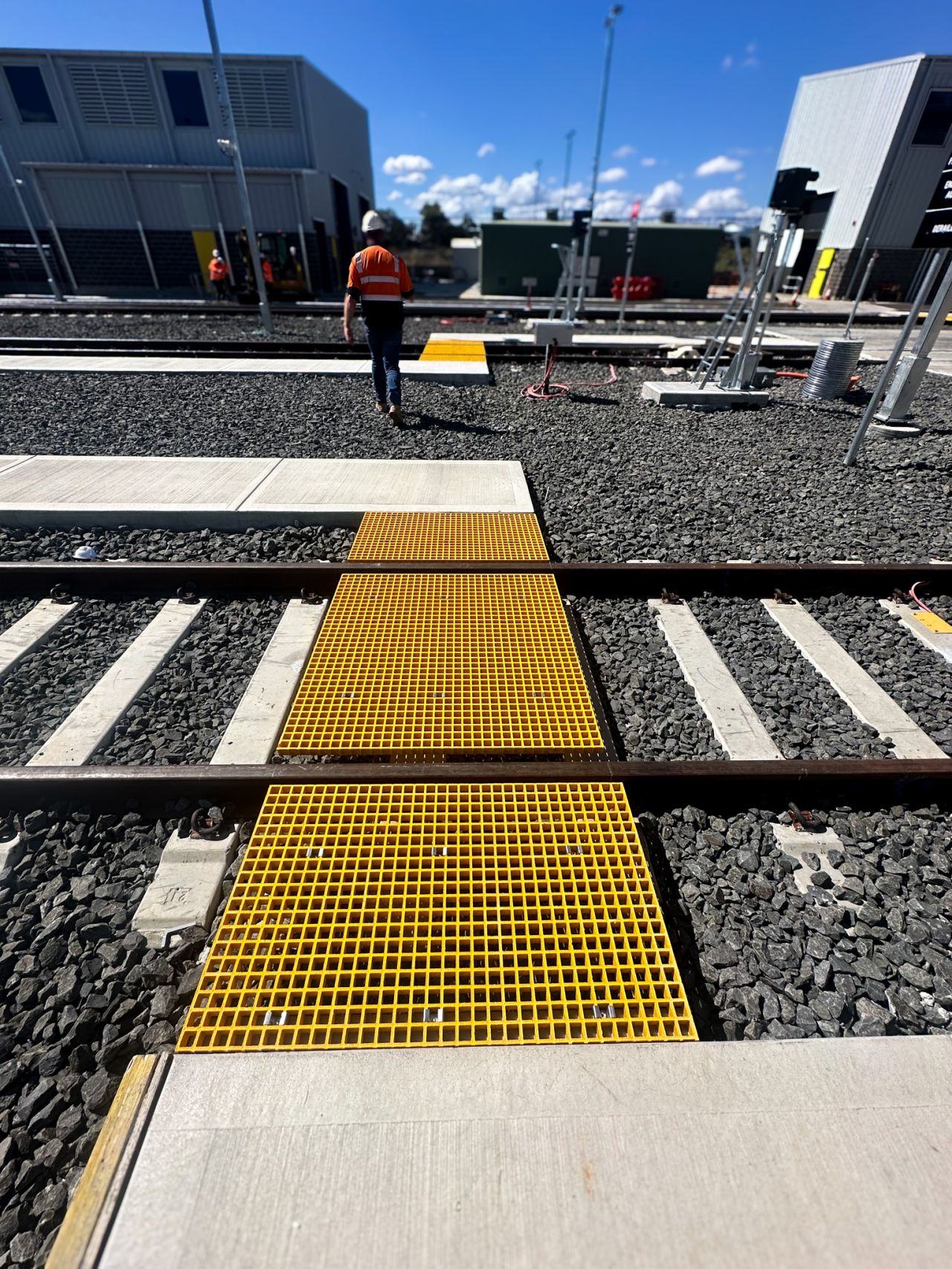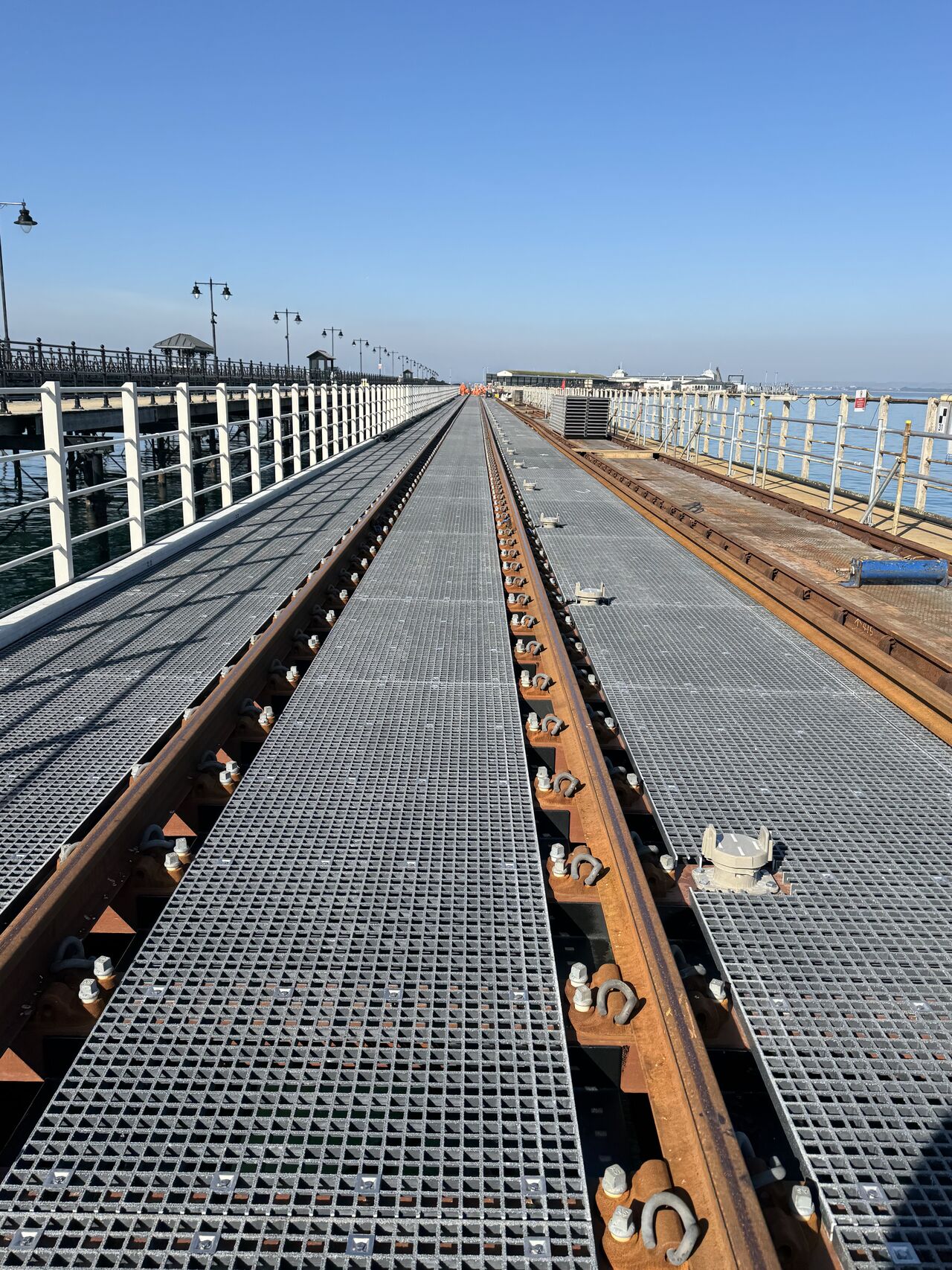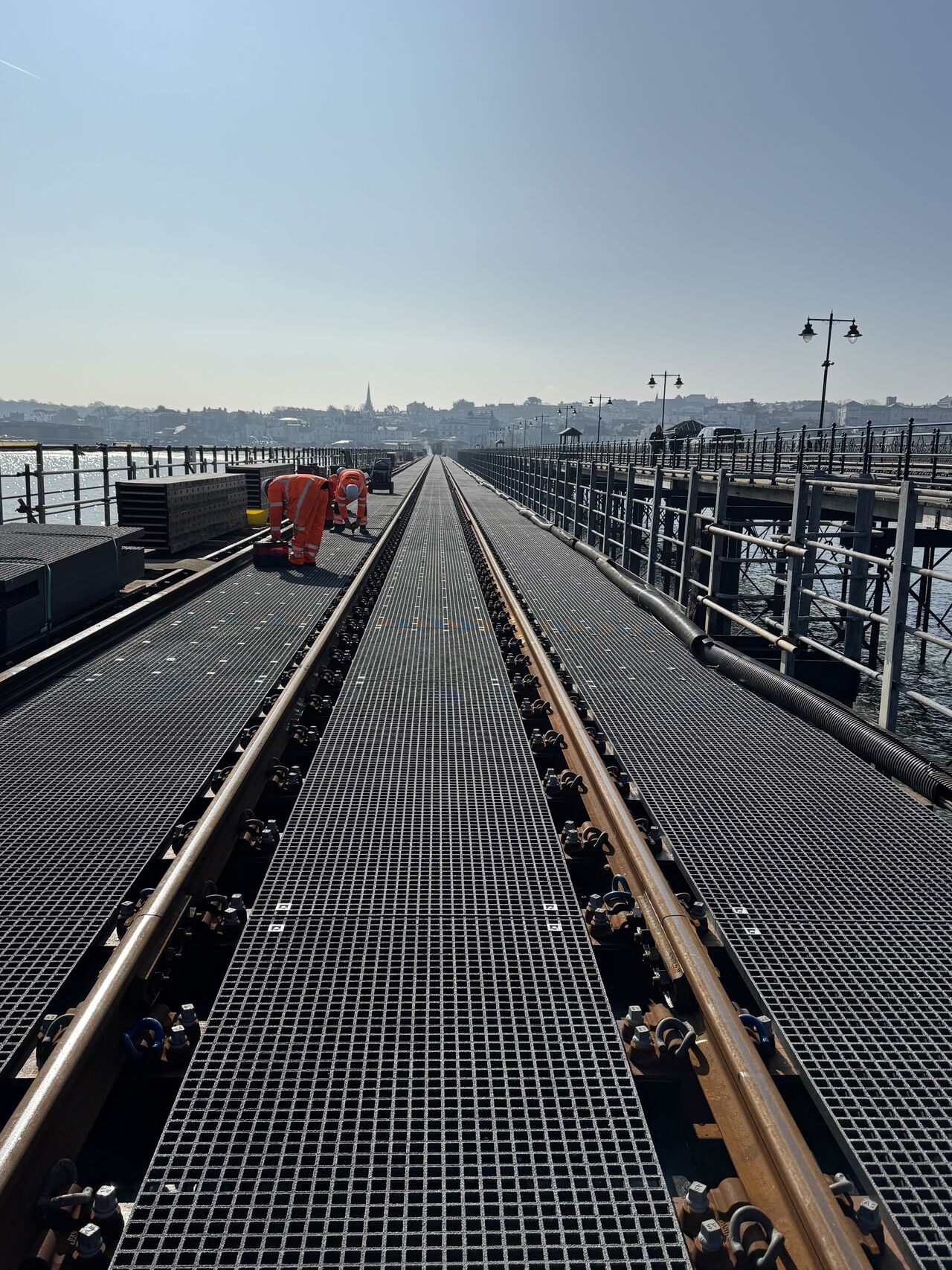With the rapid expansion of railway networks and the continuous improvement of transportation capacity, the construction and maintenance of railway infrastructure face increasingly stringent technical requirements. Traditional materials such as steel, wood, and concrete are prone to corrosion, aging, deformation, and other forms of degradation under long-term outdoor exposure. These issues lead to higher maintenance costs, frequent replacements, and safety risks.
Molded Fiberglass Reinforced Plastic (FRP) grating, with its advantages of high strength-to-weight ratio, corrosion resistance, electrical insulation, flame retardance, anti-slip surface, and minimal maintenance requirements, has emerged as a preferred material for many railway-related applications. This article explores the background, characteristics, application scenarios, technical advantages, case studies, and future trends of molded FRP grating in railway environments.
1. Challenges in Railway Line Infrastructure
Railway lines consist of a variety of facilities, including platforms, inspection walkways, overpasses, drainage systems, cable trenches, signal rooms, and protective barriers. These facilities operate under complex conditions and face the following challenges:
1.1 Harsh Environmental Exposure
Railway lines often span across diverse climatic zones—from humid, high-temperature southern regions to cold, dry northern areas, and coastal areas with high salt content. These environmental factors accelerate the corrosion and degradation of conventional materials.
1.2 Long-Term Outdoor Service
Railway facilities are constantly exposed to sun, rain, snow, ultraviolet radiation, and airborne pollutants such as acid rain or industrial chemicals. Steel structures require frequent repainting and anti-corrosion treatments, while wooden structures suffer from rot and insect infestation.
1.3 Safety Requirements
Railway operations involve high-voltage electrical systems, elevated work areas, and wet, slippery surfaces. Materials must provide reliable anti-slip performance, electrical insulation, and adequate load-bearing capacity.
1.4 Installation and Maintenance Efficiency
Given the vast distribution of railway infrastructure, installation and maintenance must be efficient to minimize downtime. Lightweight and modular materials are preferred to reduce labor intensity and shorten project timelines.
2. Structure and Properties of Molded FRP Grating
Molded FRP grating is produced using a composite of unsaturated polyester resin (or alternatives such as vinyl ester or phenolic resin) and continuous glass fiber reinforcement. The manufacturing process involves placing fiberglass rovings in a mold and saturating them with resin, followed by curing under controlled heat and pressure. The result is a one-piece, load-bearing panel with a uniform, interwoven structure.
Key Properties of Molded FRP Grating:
- المقاومة للتآكل
Resistant to acids, alkalis, salts, and various solvents. Suitable for areas affected by salt spray, acid rain, or chemical pollution. - نسبة عالية من القوة إلى الوزن
Density is about one-quarter of steel, yet the panel provides sufficient or even superior load-bearing capacity for many railway applications. - Electrical Insulation
Non-conductive material eliminates the risk of electric shock, which is particularly valuable near electrical equipment. - Flame Retardance
Can be manufactured to meet ASTM E84 Class 1 or higher flame-spread ratings for enhanced safety. - Anti-Slip Performance
Available with concave or grit-covered surfaces to significantly improve traction in wet or icy conditions. - Low Maintenance and Long Service Life
Expected lifespan exceeds 20 years with no need for painting or galvanizing. - Easy Fabrication and Installation
Can be cut and shaped using standard tools, enabling on-site customization.
3. Typical Applications Along Railway Lines
3.1 Platform Drainage Trench Covers
Railway platforms are equipped with drainage channels to manage rainwater and cleaning runoff. Steel covers are heavy and prone to rust, while molded FRP grating is lightweight, corrosion-resistant, and easy to lift for cleaning. Its anti-slip surface ensures passenger and staff safety.
3.2 Maintenance and Inspection Walkways
Regular inspection of tracks, signal equipment, and electrical systems requires safe, stable walkways. FRP gratings provide a lightweight, durable, and electrically non-conductive surface, reducing the risk of accidents during electrical maintenance.
3.3 Cable Trench Covers and Signal Room Flooring
Railway cable trenches often operate in humid, corrosive environments. FRP gratings protect cables from mechanical damage while providing a safe walking surface. Inside signal rooms, FRP flooring ensures electrical insulation and resistance to chemical exposure.
3.4 Overpass Decking and Elevated Work Platforms
Overpasses and elevated platforms must withstand the weight of personnel and tools while exposed to harsh weather. FRP gratings retain strength, resist corrosion, and maintain anti-slip performance even in snow and rain.
3.5 Drainage and Flood Protection Facilities
FRP gratings are used for covers on drainage channels and inspection points along flood protection systems. Their light weight facilitates quick removal and replacement, improving maintenance efficiency.
3.6 Safety Barriers and Protective Enclosures
Areas such as high-voltage zones and equipment enclosures require physical barriers. FRP gratings, shaped into panels or fences, provide strong, corrosion-resistant, and electrically insulated barriers.
4. Technical Advantages Compared to Other Materials
| ملكية | شبكة FRP مصبوبة | Carbon Steel Grating | Aluminum Grating | Wooden Planks |
|---|---|---|---|---|
| كثافة | 1.8–2.0 g/cm³ | 7.8 g/cm³ | 2.7 g/cm³ | 0.6–0.9 g/cm³ |
| المقاومة للتآكل | ممتاز | فقير | معتدل | فقير |
| Electrical Insulation | ممتاز | Conductive | Conductive | ممتاز |
| Flame Retardance | High (customizable) | Requires coating | معتدل | فقير |
| سطح مضاد للانزلاق | ممتاز | معتدل | معتدل | فقير |
| Maintenance Cost | Very Low | عالي | Medium | عالي |
| Service Life | 20+ years | 5–10 years | 10–15 years | 3–5 years |
This comparison shows that FRP grating offers superior long-term performance and safety while reducing life-cycle costs.
5. Case Studies in Railway Applications
Case 1: Platform Trench Cover Replacement in a High-Speed Rail Station
A section of a high-speed railway platform originally used steel trench covers that became heavily corroded within five years. Replacement with molded FRP grating reduced weight by 60%, halved removal and cleaning time, and eliminated corrosion-related maintenance.
Case 2: Coastal Railway Overpass Upgrade
An overpass in a coastal railway corridor experienced severe rusting of its steel deck panels due to salt spray. Grit-surfaced FRP grating was installed, significantly improving anti-slip safety during wet conditions and eliminating annual repainting.
6. Future Development Trends
With the modernization and digitization of railway infrastructure, FRP grating is expected to evolve in the following directions:
- Lighter and Stronger Designs: Improved resin systems and fiber architecture to achieve higher load capacity without increasing weight.
- Modular Standardization: Uniform sizes and connection systems to enable faster installation and replacement.
- Multi-Function Integration: Incorporation of anti-static, UV-resistant, and enhanced fire-safety properties for extreme environments.
- Sustainable Materials: Adoption of recyclable resin systems and greener manufacturing processes to reduce environmental impact.
7. Conclusion
Molded FRP grating is increasingly recognized as a reliable solution for a wide range of railway infrastructure applications—from platform trench covers and inspection walkways to overpass decking and protective barriers. Its combination of corrosion resistance, electrical insulation, anti-slip performance, and low maintenance requirements makes it an ideal choice for ensuring the long-term safety and efficiency of railway operations.
As railway systems continue to expand and modernize, molded FRP grating will play an even greater role in enhancing infrastructure durability, reducing operational costs, and supporting sustainable development goals. The material’s adaptability, performance, and cost-effectiveness will ensure its continued adoption in the railway industry for decades to come.




